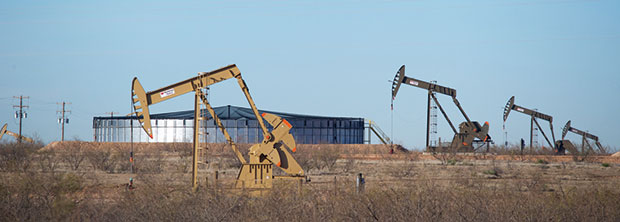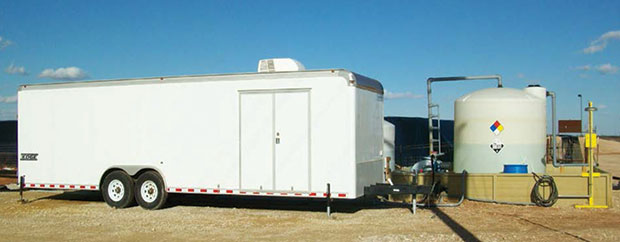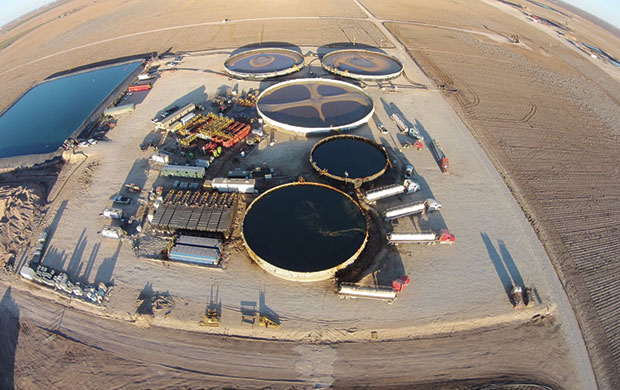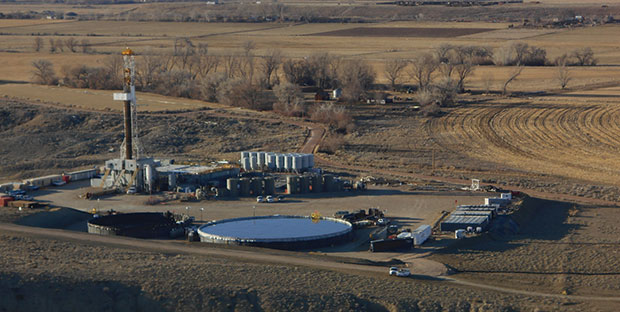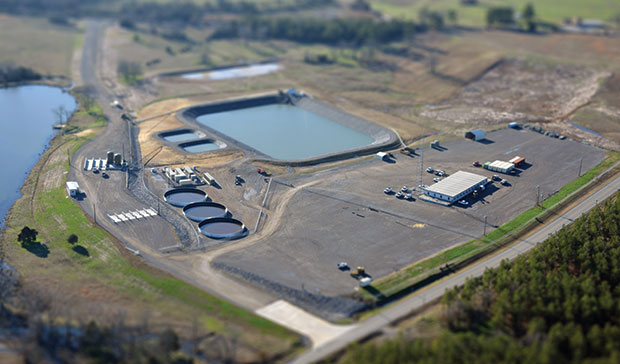
Water Management
Recycling, Treating Practices Enable Operators To Conserve Freshwater Supply Resources
By Danny Boyd, Special Correspondent
Stimulation and completion operations in horizontal resource plays can require hundreds of thousands of barrels of water per well. While that number sounds large, any discussion of water use in the oil and gas industry must begin by acknowledging that the amount of freshwater pumped each year in well stimulation operations equates to less than 1 percent of total U.S. consumption, according to published statistics.
That point noted, there is no more precious natural resource than water. Recognizing that reality, and reflecting a broad industrywide commitment to stewardship of freshwater resources, oil and gas operators across the country are leveraging water management best practices and cutting-edge technologies to recover, treat and reuse water from flow back and production operations, thereby drastically reducing or altogether eliminating requirements for freshwater supplies in hydraulic fracturing jobs.
Instead of using freshwater, some companies are sourcing “water wells” from reservoir intervals that contain naturally brackish water that has no other beneficial use. Some mix brackish water with recycled produced water in well stimulation and completion operations.
A case in point is Apache Corporation, which continues to develop flow-back and produced water treatment processes and facilities in a move that Cal Cooper, director of emerging technologies, says is reducing the company’s needs for freshwater substantially in its Permian Basin operations, and is cutting associated truck traffic on local roadways. Apache also is using brackish water from the Santa Rosa formation (lower sandstone zones in the Dockum Group) located at subsurface depths of 800-1,200 feet–hydrologically separated from the shallow freshwater aquifer at 300-600 feet–to help supply its needs for frac jobs.
The company’s water management practices are proving to be environmentally as well as economically beneficial, Cooper notes.
He says drought conditions and a desire to recycle and reduce costs for hydraulic fracturing inspired Apache to develop a facility in Irion County, Tx., capable of treating and storing produced water in large, lined grain bins for reuse in the company’s slickwater fracs in the region. The facility is capable of treating 40,000 barrels of produced water a day.
“We have a central processing facility that includes six of these large grain bins of produced water, but we also have two other areas with additional bins that are connected to it,” he says.
Apache Corporation has developed centralized facilities with the daily capacity to treat 40,000 barrels of produced and flow-back water, substantially reducing freshwater needs in its Permian Basin operations. The treated water is stored in lined bins that can hold up to 27,000 barrels. Apache also is using treated brackish water from the Santa Rosa formation to help supply its needs in the basin.
Large, lined, in-ground pits store the brackish water from the Santa Rosa formation to supplement treated produced water when needed, according to Cooper.
Produced water, depending on its source, and how long wells have been flowing, typically ranges from 80,000 to 120,000 parts per million of total dissolved solids. “More mature wells tend to produce water with higher TDS levels, while more recently completed wells have lower amounts of TDS, but it all gets mixed and sent to the grain bins lined with heavy-duty plastic liners, (which are) plumbed for treatment and transfer,” he explains. “Steel nets on the top keep birds out of the facilities.”
The bins are about 14 feet high and normally hold up to 27,000 barrels of fluid that can be loaded from the top or bottom, although the tanks typically are not kept completely full, he says. The produced water is treated with chlorine dioxide, a chemical commonly used in municipal water treatment plants, he says.
“Our contractors make chlorine dioxide on site, which minimizes potential exposure and spill issues,” Cooper continues. “Chlorine dioxide also breaks down the polymers, iron and organic substances. The process causes solids and impurities to float to the top, where vacuum trucks vacuum them off.”
Reduced Truck Traffic
The significant growth in truck traffic across the Permian Basin has been a common concern for communities, residents, and oil and gas operators alike, Cooper acknowledges. But dedicated, above- and below-ground transfer lines allow treated water from the Irion County facility, located near the community of Barnhardt, to be utilized throughout the area, drastically reducing truck trips.
“A lot of people in West Texas do not want all those trucks on the road, including me,” Cooper says. “In 2014, we treated and recycled more than 10 million barrels of produced water. That is not Santa Rosa water, but produced water. We used all that in frac jobs. Because we did not truck the water anywhere, we took more than 80,000 truckloads of water off the road. Officials with the Texas Department of Public Safety and local law enforcement are thrilled that we are able to recycle water and reduce the number of water trucks traveling the roads every day.”
Compared with water co-produced from Permian Basin oil and gas wells, brackish water sourced from the Santa Rosa formation requires relatively little treatment, he says. Treatment it does require typically includes adding biocides or using ultraviolet light to eliminate bacteria, he says. Treatment typically can occur at the site of a frac job.
“If we have a 500,000-barrel lagoon of Santa Rosa water that sits under the West Texas sun for part of the summer, that water is going to grow a lot of bacteria,” Cooper notes. “We have to make sure we are not putting bacteria-laden water into a frac job because that could cause issues down hole that impact production.”
The aboveground storage lagoons range in size from 300,000 to almost 600,000 barrels when full, he says. The pits are connected with lay-flat pipe and underground pipe to flow water from one pit to another to ensure ample water supplies in various locations.
Apache’s facility is designed to meet its local water needs for 25 years, if necessary, Cooper says. Whatever the time frame proves to be, Cooper says treating flow back and produced water is very quickly becoming a routine part of the business for operators in the basin.
“Treating produced water makes sense from any perspective, including economics. If you are sending produced water to a disposal well, you may as well reuse it, especially if you can reuse it at a lower cost than disposal,” he points out. “With our cost structure, we believe it is more economic and logistically easier to treat water and reuse it than to truck it for disposal.”
Utilizing Brackish Water
In the often-parched plains of West Texas, a reliable source of freshwater can be almost as valuable to a rancher or farmer as a good oil well on his property. At the end of 2014, Fasken Oil and Ranch Ltd., achieved its goal of discontinuing the use of freshwater for drilling and hydraulic fracturing in the Permian Basin, says Jimmy Davis, director of oil and gas operations.
Fasken Oil and Ranch Ltd. has discontinued using freshwater for drilling and hydraulic fracturing in the Permian Basin, and now uses only treated brackish water from the Santa Rosa formation along with recycled produced and flow-back water. Shown here is a sulfate removal system on location treating Santa Rosa water.
Instead, Fasken now is using only treated Santa Rosa brackish water with recycled produced water for oil and gas operations as part of a program to conserve freshwater for operations on the expansive ranch north of Midland.
“We made a conscientious decision a few years ago to try to discontinue using freshwater on the ranch because there is not much freshwater available there,” Davis explains. “The freshwater wells are not that prolific and there are not many places where it is economic to drill for it. The Fasken family has had the ranch for 101 years and freshwater is getting to be in short supply.”
By definition, brackish water has a saline content as high as 3 percent. In the case of the Santa Rosa sandstones, the source of the salinity is evaporites of the Permian Sea that once covered the area. Treating Santa Rosa water includes processes to remove sulfates and filter the water through membranes to prepare it for use, Davis says. Water from the Santa Rosa can be mixed with cement on the drilling site in lieu of freshwater, while frac jobs utilize it once it has been processed to reduce sulfates, he elaborates.
Initially, the company utilized a new technology in an attempt to remove sulfates from Santa Rosa water, but was unsuccessful. The sulfates needed to be removed because some producing zones contained strontium that, when combined with the brackish water, could form strontium sulfate, which could permanently plug producing zones, Davis elaborates.
Some wells were subsequently fractured hydraulically with a 50/50 blend of freshwater and Santa Rosa water to dilute the sulfate concentration, which eliminated 50 percent of freshwater needs. After subsequent research, the company identified economical ways to remove sulfate from the water, which led to a decision to use 100 percent Santa Rosa water for frac jobs, Davis says.
“Plus, we were making quite a bit of produced water and wanted to be able to treat that water and reuse it rather than pumping it into our disposal system,” he says.
During the fall of 2014, Fasken was using 5,850 barrels a day of treated Santa Rosa water on four rigs drilling at the time, Davis reports. Fasken was producing 10,000-11,000 barrels a day of produced water, recycling about 80 percent of that daily total for use in fracturing operations, he relates.
Produced water is gathered at a disposal facility and piped into an electrocoagulation unit that causes suspended solids to coalesce, Davis explains. Water is pumped into an open-top steel tank that contains baffles to accelerate solids settling. Water then flows into two horizontal, 500-barrel settling tanks before being pumped into a 125,000-barrel double-lined storage pit. Water is pulled from the storage pit and pumped as needed to frac job sites.
To date, Fasken has been using a blend of 60 percent recycled water and 40 percent treated Santa Rosa water, he says. Despite the slowdown in drilling, Davis reports that Fasken will continue to use a combination of Santa Rosa and produced water to meet all future needs on some 2,000 well sites yet to be drilled.
“It may be a while before we seriously ramp up drilling again, but those sites will be drilled and completed eventually,” he says. “We require more than 2 million gallons of water per well, and considering the number of locations, the ability to drill and stimulate them without using freshwater will be just as important to us in the future as it is today.”
‘Good Citizen’ Solution
Birmingham, Al.-based Energen Corp. also continues to evaluate its use of brackish water from the Santa Rosa formation beneath the Midland Basin to supplement freshwater used to hydraulically fracture its horizontal wells targeting the Wolfcamp formation, says Davis Richards, vice president of drilling and completions.
The company has achieved as much as 70 percent recycled water use in an individual well stimulation, he says, with recycled water typically meeting between 35 and 45 percent of the total volume needed on any given frac job.
Energen Corp. has achieved as much as 70 percent recycled water use in hydraulic fracturing operations on its horizontal Wolfcamp wells in the Permian Basin. It also continues to evaluate using brackish water from the Santa Rosa formation, and has drilled five Santa Rosa water wells to date.
Water demand per frac job varies greatly, depending on frac design and the number of frac stages, Richards says.
“Obviously, Energen wants to do its part to conserve freshwater, especially in areas where there may be shortages or that may be drought-prone,” he says. “We feel it is the right thing to do to be a good citizen in the communities in which we are working.”
Thus far, the company has drilled five brackish water wells into the Santa Rosa, Richards details, with water quality, and the extent of required treatment, varying by location.
“We have seen some variations in the quality of the brackish water. In some areas, we have been pleasantly surprised by how good the water quality is,” he reports. “We have had fairly low chlorides and the water has been useable in our frac designs.”
In areas where disposal and related transportation costs are higher, recycling makes both economic and environmental sense, he says, and is especially beneficial in areas with a concentration of producing wells.
The company’s Five Stones area in Glasscock County southeast of Midland includes a concentration of well sites being drilled, he notes. “We have installed the infrastructure that enables us to recycle produced and flow back water, as well as move water around the field, as needed,” Richards says. The company is preparing to embark on a drilling program in the San Juan Basin targeting the oil-bearing Mancos Shale, and plans to assess water recycling needs as the play develops.
“We are encouraged by the environmental and economic benefits we are realizing through our efforts to reuse and recycle water,” Richards says. “We, like other operators, are committed to making a concerted effort to conserve water where we can.”
Reusing Produced Water
Newfield Exploration Company has achieved 98 percent produced water treatment and reuse in its Utah operations, says Lloyd Hetrick, operations engineering adviser. This effort provided about 30 percent of the total required for Newfield’s hydraulic fracturing operations in Utah last year, he points out.
These operations include three developments. The first is Green River, which is an active waterflood using vertical wells and a hybrid fracturing design for new wells. The other two are the Wasatch and Uteland Butte plays, which are developed with horizontal wells that also use hybrid fracturing designs for new wells.
Newfield Exploration Company has achieved 98 percent produced water reuse in its Utah operations, which include the Green River waterflood and the Wasatch and Uteland Butte horizontal plays. Newfield’s treatment techniques vary by the condition of the recovered water and reuse objectives, but can include separation, chemical treatment and filtration, electrocoagulation and microfiltration. Shown here is the company’s DART recycling facility.
“The Green River development is a waterflood, so for every barrel we take out we try to put one back in. At this point, we are putting more in than we are taking out because we are trying to maintain reservoir pressure,” Hetrick notes.
Water treatment techniques vary by the condition of the produced water recovered and the specific reuse objectives. Hetrick says Newfield’s process includes basic separation, chemical treatment and filtration, plus higher-order electrocoagulation treatment and microfiltration.
“It would be fair to say that we use the most basic level of treatment–separation, filtration and chemical adjustment–for the entire waterflood,” Hetrick explains. “A portion of that water is treated additionally with the electrocoagulation process and another portion receives microfiltration treatment.”
The 98 percent reuse achievement may be as close as possible to 100 percent when considering that 1 to 2 percent of the stream includes solids and other matter that is properly removed and disposed, he says.
“We recycle everything from all three plays,” he states. “Water from the Wasatch and Uteland Butte that cannot be reused in hydraulic fracturing is diverted to the waterflood, so we have options.”
Most water is piped between the projects, Hetrick says, adding that there are still remote locations where water has to move by truck.
Generally, the company is more likely to recycle during the more mature development phase instead of during early exploration when Newfield is working to delineate the extent of oil and gas reserves, but water recycling is not an afterthought, Hetrick insists.
“Once we get past the point of exploration and transition to the development phase, recycling becomes an integral part of the operation,” he says. “We have some level of recycling in all our development plans. We are planning into the future, so when we transition from exploration to production, we make sure water is part of that early transition.”
Water recycling and reuse will continue to grow in importance as the oil and gas industry continues to develop shale plays around the country, especially for Newfield and other operators who belong to the 18-member Energy Water Initiative, he assesses.
“We all recognize that the old way of waiting until you have it all figured out and then throwing recycling into the mix causes you to miss huge opportunities,” Hetrick concludes. “We try to get it in as early as possible to make it an economic part of our continuous improvement process.”
Southwestern Energy Company is using central treatment facilities to achieve near-zero disposal of produced water from its Fayetteville and Marcellus operations. It is recycling 99 percent of flow-back and produced water to supply more than 40 percent of the total water volume pumped in Fayetteville and Marcellus well fracturing. The centralized facilities are part of the company’s ECH2O Energy Conserving Water® initiative to guide water recycling, reuse and replenishing of freshwater sources.
Near-Zero Disposal
Southwestern Energy Company is using central water treatment facilities to achieve near-zero disposal of produced water from operations in the Fayetteville Shale, and is accomplishing similar results in the Marcellus Shale, says Rowlan Greaves, strategic solutions project manager.
“We reuse and recycle 99 percent of the flow back and produced water from our main operations in the Fayetteville and Marcellus shale plays,” he states. “Reusing this water comprised more than 40 percent of the total water used for hydraulic fracturing in our Fayetteville and Marcellus operations in 2014.”
Developing centralized facilities is part of an initiative the company launched in early 2013 called ECH2O Energy Conserving Water® to guide water recycling, reuse and replenishing of freshwater sources, he says. The company’s goal is to be freshwater neutral by the end of 2016 by minimizing freshwater consumption and continuing to use recycled flow-back water, Greaves details.
Two centralized water treatment facilities in the Fayetteville Shale are part of a reuse/recycle system that processes water from about 4,000 wells, details Mark Mazoch, operations management water team manager.
The facilities include storage lagoons and treatment systems. Both facilities use primary settling to remove large solids that include sand, he outlines. At the eastern facility, additional processing includes aerobic biological treatment followed by either filtration or induced gas flotation. The facility utilizes mechanical vapor recompression to desalinate the water before it is pumped to verification tanks and sampled for quality, Mazoch says.
The eastern facility can treat water for discharge to a stream, allowed under a National Pollution Discharge Elimination System permit, he says.
The majority of water from Southwestern’s Fayetteville facilities is trucked from one well site to another within a large 40- by 70-mile area, Mazoch says.
“Our reuse efficiency also benefits us when conditions allow flow-back water to be pumped aboveground from an adjacent well pad that is close enough to use a single high-density polyethylene line between well pads,” comments Mazoch. “In the Fayetteville Shale, our efforts to transport water directly from a producing location to a job site for immediate reuse is the primary means of reducing truck trips. Over the past two years, we have been able to meaningfully reduce truck trips per the amount of water we manage.”
For other great articles about exploration, drilling, completions and production, subscribe to The American Oil & Gas Reporter and bookmark www.aogr.com.







